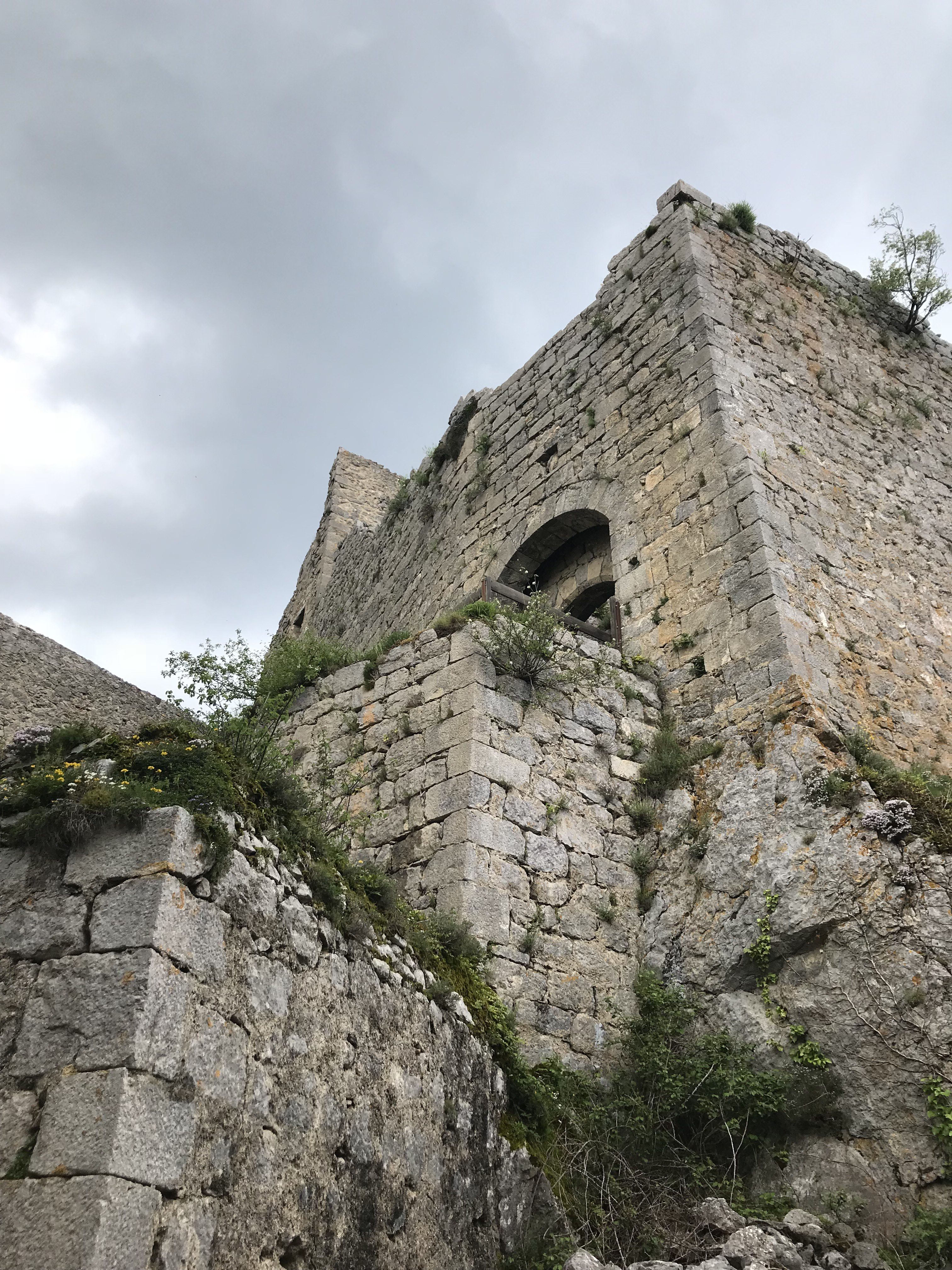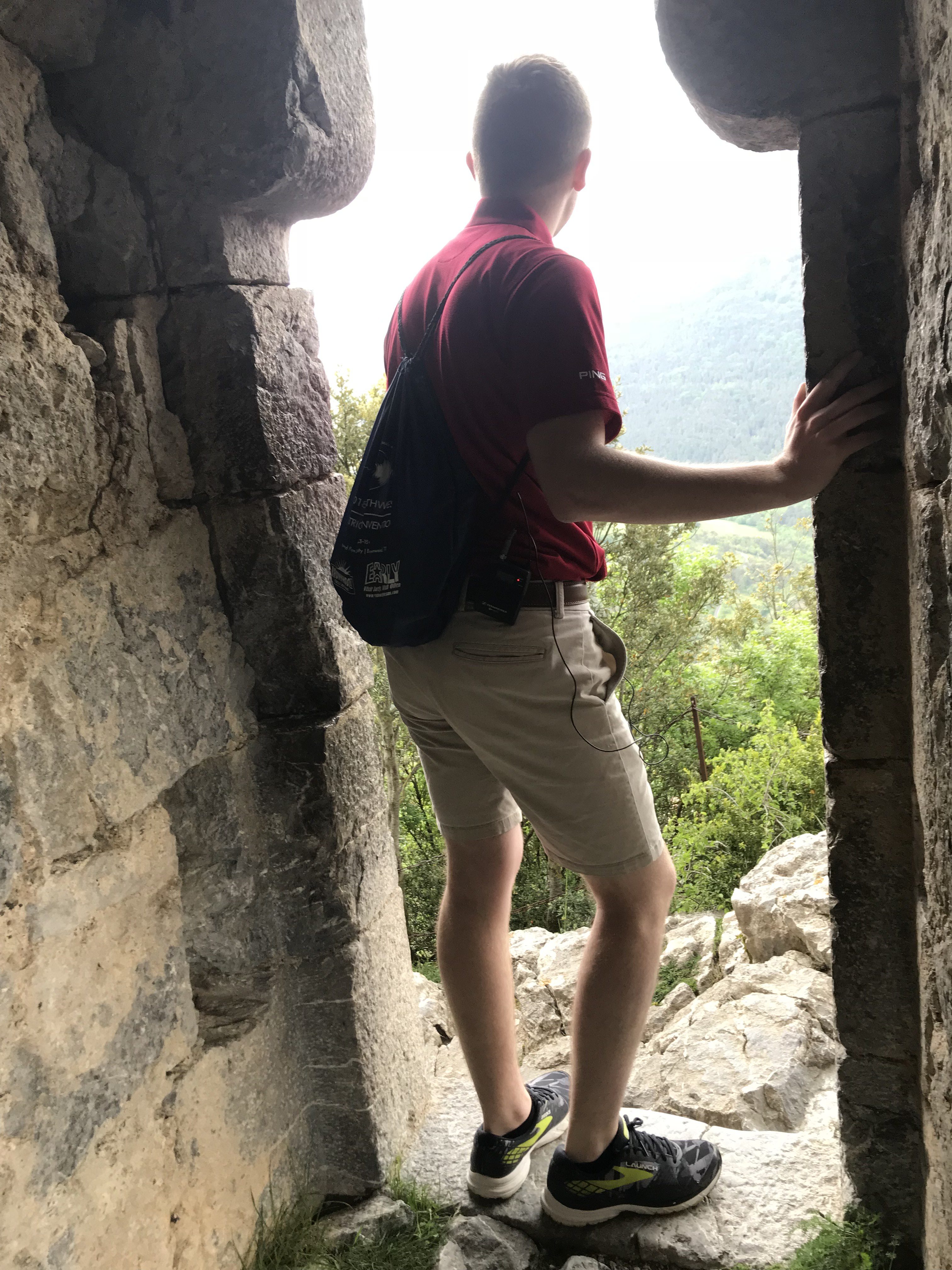At first, freshman chemistry major Jacob Purifoy worried about connecting with the liberal arts-minded students and historical sites during our Honors Passport: Pilgrimage trip, but he quickly discovered his own passion for history and the beauty of sharing interdisciplinary interests. He gave a riveting presentation on Cathar history at Puilaurens Castle during the trip, and in this blog post, he channels with startling historical accuracy the final moments of a “heretical” resistant protecting the last bastion of Cathar perfects in the stronghold, even as it falls to Louis IX’s forces in 1255.
Imagine being awoken to the sight of damp darkness in a field of gray. The frantic ring of bells from above had startled you. Light penetrates the room in waves as dust from vibrations briefly interrupts and scatters the rays all about. Armor that shines in crimson with a golden cross layered on it sits to your side. You hurry and equip your tunic and rush to the window slits of the rounded room, already finding others doing the same. Outside, the foreground is lined with men running about battlements and crenellations while dust clouds the distance. Shades of blue become apparent, along with the trotting of horses and men.
You come to your senses; proudly wearing chainmail and the symbol of the County of Toulouse, you recognize yourself as one of the few remaining good men of the Christian Church. You stand in the great stone keep of the Chateau de Puilaurens, a “Cathar” castle in the Pyrenees. Up the mountains in the distant hills march the pilgrims under the Papal and Capetian yoke. They come now as crusaders, seeking to “restore order” to an annoyingly unsympathetic southern France.
This does not seem right though… If you are one among the many “good men” defending Christianity, why would Louis IX dare march his soldiers away from the Saracens in the East to confront you in Occitania? Your parents had always raised you to have pride for your southern Occitan roots, and during pressing times sent you to the tutelage of a man they called “the perfect.” He talked much about the follies of the Church hierarchy and union with the State. He hated the practices of the Church and its grotesque earthly depictions of Christ and the flesh. He sought freedom and equality among the fierce peoples of Toulouse, and for them to connect more with the Holy Spirit for direct contact with God. There were many suspected proto-Protestant overtones.
The French Crown in the north, meanwhile, had collectively labelled such autonomous Toulousians as “Cathars.” The missionaries initially sent to your homelands reported that the people were stubborn and self-minded about Biblical interpretation and teaching. This sparked a concern for the Catholic Church about possible heresy, and for the French State about a possible rebellion. It is why, with the backing of Pope Innocent III, the Albigensian Crusade (named after the Ecclesiastical province of Albi) began some 40 years ago and culminates in the current moment.
After all this time under your teacher you were not sure if he was a nationalist, an anarchist or a heretic, but there are no chances for questioning now. The foundations shake around you as friendly archers retaliate. The attackers reach a sieging position. Machines of war are constructed, and supplies are assembled. Belfries provide the besiegers cover as they near the walls. Siege engines are now fully battering the walls. The few Toulousian castle defenders undergo their consolamentum – a pledge of monastic chastity and salvation – and prepare for siege. Down in the courtyard, men, women and children rush, carrying water from the cistern and ammunition from the tents.

Any attackers would have had a difficult time taking Puilaurens, due in part to its strategic location high atop a steep, narrow mountain.
At first, things seem hopeful as the zig-zag approach to the fortress creates logistical havoc for the crusaders. A melee of swords ensues, briefly interrupted by volleys of arrows and the occasional pouring of boiling water by defenders above. Horses are unable to scale the steep cliff. The heavy armor of the royal soldiers fatigues them fast.
Their sheer numbers, however, eventually prevail. The attackers break through the main gates and storm the lower courtyard. Last-ditch efforts are made by defenders who operate in weapon batteries facing within the castle. The crowd of dark blue French flags flooding the castle are still shadowed by the proud crimson and gold of Toulouse flying above the keep.
You are part of the final rally to protect the last “perfect” teachers. While you are never completely sure of what you have gotten yourself into, one thing is for certain: you have never been closer or more empathetic to the last martyrs fighting around you. It is a romantic, yet very real picture. Clashing swords for religious freedom and personal liberties; shouting chants for representative autonomy and cultural pride; and in all of this attempting to preserve an Occitan way of life through the perfects. You are all good men for the good God and country. But the Capetians will prevail in this last “Cathar” refuge.
————————————————————————————————————————
Taking in all the sights and stonework of this mountain fortress in the present, I became enamored with its more ambiguous history as compared to other Toulousian castles. I was inspired to create this historical narrative of what it really may have been like in the life of an able and ambitious Toulousian of the mid-13thcentury. This pilgrimage on the Camino de Santiago has really expanded my awareness of the evolution of medieval history and architecture and its function within the space of its heyday. I have seen great Gothic cathedrals, treasured reliquaries, cliffside villages, Roman spectacles, and towering castle walls! And of course, being granted the opportunity to dissect medieval heresies/rebels and their relation to the castles giving them refuge and strength has been no less than phenomenal.
I will always treasure the knowledge I have gained and spiritual journey I have sought on this expedition. I have been inspired to return as an academic one day, and until then, Camino por buen Camino!


